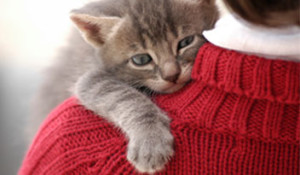Cats have become one of the best loved pets in the world. They really make quite wonderful pets and most people own one or more. Many people attest they make the best companions. However, owning a cat can be somewhat uncomfortable for the person who has allergies. And, unfortunately, cat allergies are a major form of allergies, striking many people. Of course, the ideal situation is to own a cat and not be affected by being allergic to it. That may not be a realistic situation, however.

Just like their more clumsy opposite, the dog, cats produce dander, which is the foremost offender where allergies are concerned. Dander from a cat or a dog is actually skin which is shed, not hair, as small flakes. It irritates skin, certainly, but more than that, it can get into the immune system causing an uncomfortable number of allergic reactions and symptoms. The immune system recognizes dander as a threat to the body and immediately begins its fight against the substance. Itchy eyes, sneezing, coughing, and even a rash can develop from the exposure. These symptoms are a result of the immune system releasing certain chemicals to demolish the intruder within the body. Other cat allergens can come from their saliva, blood, and urine. These substances can continue to remain active in the environment even though the cat may be no longer present.
 Since cats also groom themselves all the time, rubbing their saliva into the fur, they are spreading the dander and allergens all around them. The owner of a cat will sooner or later end up carrying the dander and allergens around on clothes, skin, hair, and face. The home of the owner will also have a multitude of the allergens and dander inhabiting carpets, drapes, furniture, beds, and even on the dining table. People will react in different ways to the cat allergens so it is very difficult to diagnose the allergy. The general symptoms of this cat allergy, though, are usually the same: sneezing, coughing, itchy, watery eyes, and even some trouble with breathing. If fever or chills develop, the person should immediately contact the doctor (although this reaction is usually rare).
Since cats also groom themselves all the time, rubbing their saliva into the fur, they are spreading the dander and allergens all around them. The owner of a cat will sooner or later end up carrying the dander and allergens around on clothes, skin, hair, and face. The home of the owner will also have a multitude of the allergens and dander inhabiting carpets, drapes, furniture, beds, and even on the dining table. People will react in different ways to the cat allergens so it is very difficult to diagnose the allergy. The general symptoms of this cat allergy, though, are usually the same: sneezing, coughing, itchy, watery eyes, and even some trouble with breathing. If fever or chills develop, the person should immediately contact the doctor (although this reaction is usually rare).
Naturally, a doctor should be consulted anyway. In seeing a doctor, the person with cat allergies will be examined and properly diagnosed with allergy tests and a physical examination. The doctor will prescribe medications and a proper treatment action plan. Usually treatment will consist of antihistamines and decongestants, which help with nasal passages which are swollen and with coughs. Allergy shots may also be given since they can prevent an allergy attack. Those who are seriously allergic to cats should probably receive such shots. These treatments will help dramatically lessen the risk of suffering from cat allergies and lessen the symptoms and their severity.
 Of course, the best option for taking care of cat allergies is an action no true cat lover would ever want to do. The cat may have to go to another home. Most cat lovers will have a very difficult time in doing this and would rather suffer somewhat than give their cat or cats away. However, if the cat allergies grow too severe in their allergic reactions, or symptoms, the cat owner may have to force the issue and give up his or her cat. Although the cat owner could possibly continue getting treatment for the cat allergies, that route of keeping the cat or cats could prove to be very, very expensive. Besides this, the doctor is only human and quite limited in helping the person who stubbornly refuses to give up his or her beloved pet. However, as in all decisions, this is one decision only the person who loves cats can make: to keep the cat and keep the allergies or to give away the cat and feel very sad. It is a difficult decision, but it can be made.
Of course, the best option for taking care of cat allergies is an action no true cat lover would ever want to do. The cat may have to go to another home. Most cat lovers will have a very difficult time in doing this and would rather suffer somewhat than give their cat or cats away. However, if the cat allergies grow too severe in their allergic reactions, or symptoms, the cat owner may have to force the issue and give up his or her cat. Although the cat owner could possibly continue getting treatment for the cat allergies, that route of keeping the cat or cats could prove to be very, very expensive. Besides this, the doctor is only human and quite limited in helping the person who stubbornly refuses to give up his or her beloved pet. However, as in all decisions, this is one decision only the person who loves cats can make: to keep the cat and keep the allergies or to give away the cat and feel very sad. It is a difficult decision, but it can be made.
